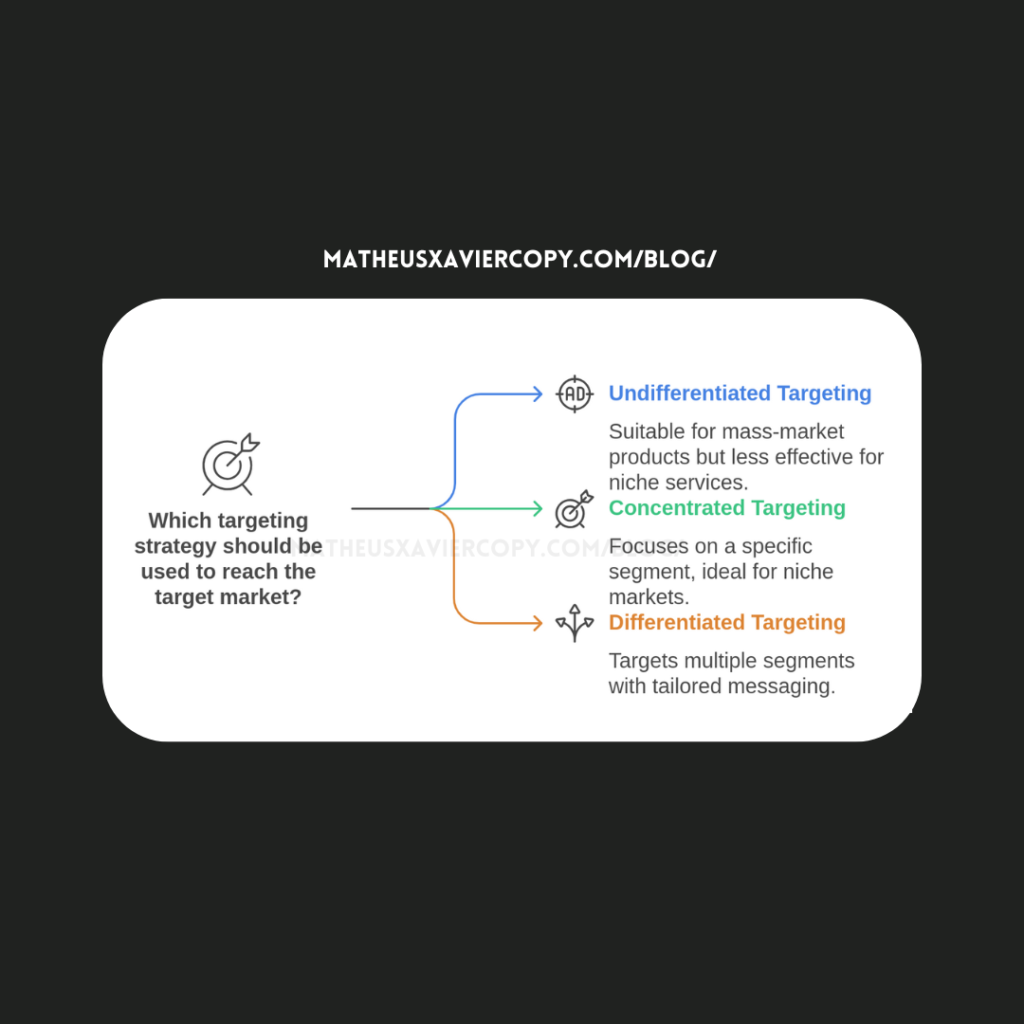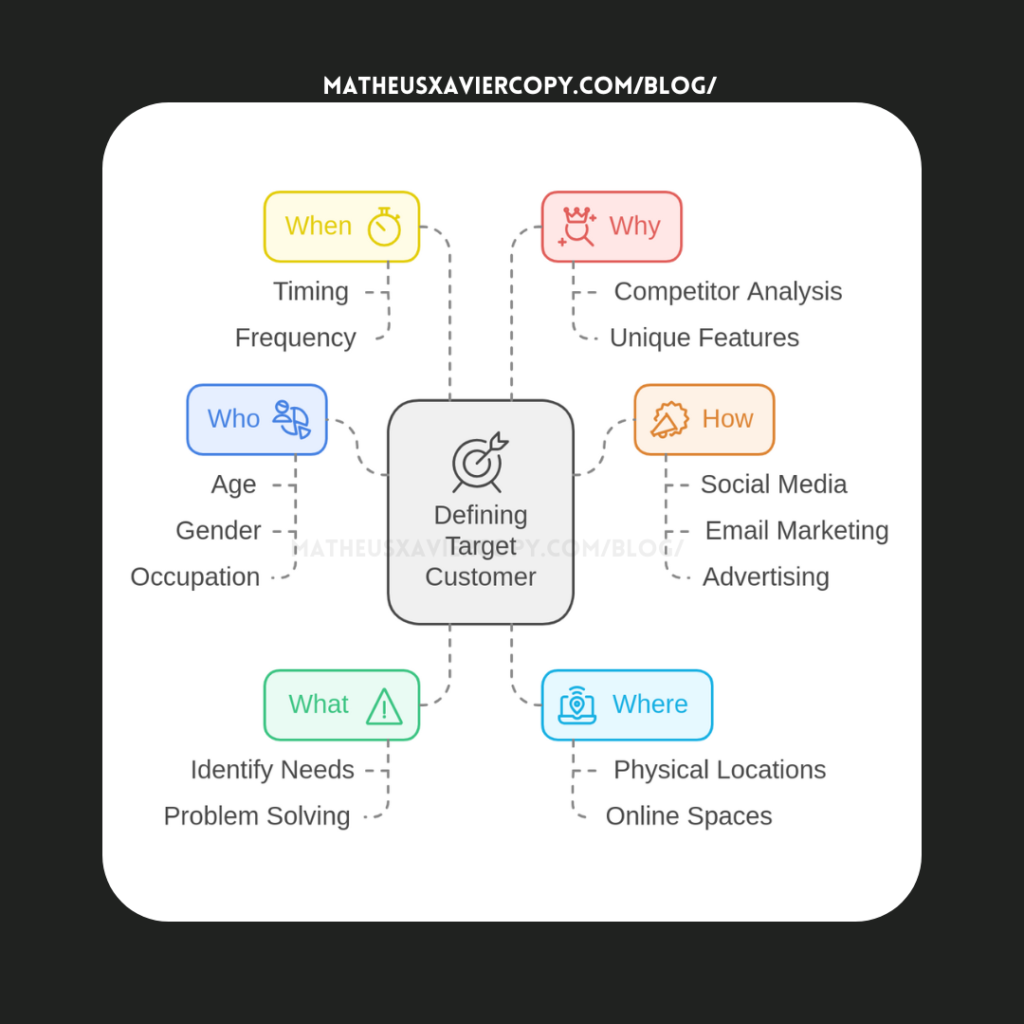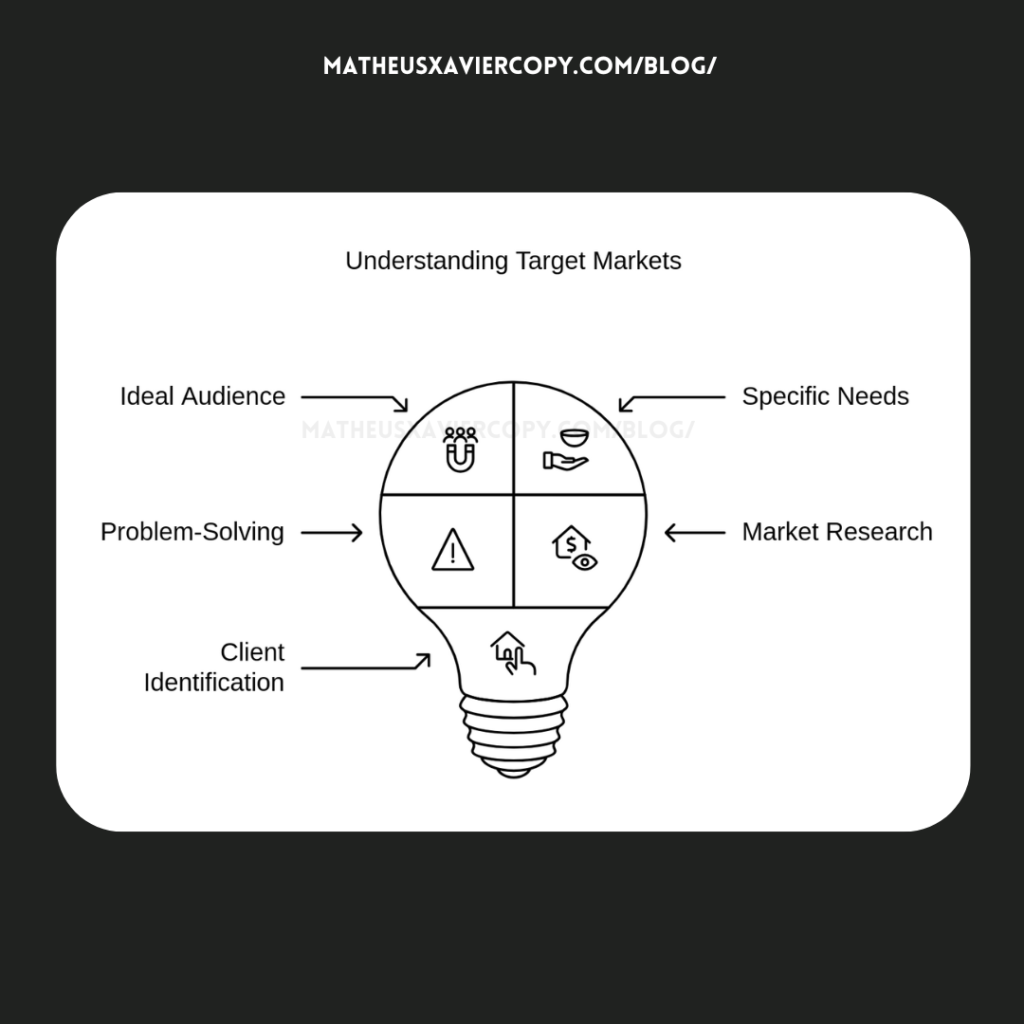Target marketing is one of the most important aspects for companies and freelancers. That’s why I wrote this content with 5 proven steps to identify and reach yours effectively.

Target Market: 5 Steps to Identify and Reach Yours
What Is the Meaning of Target Market?
Think of a target market as your ideal audience—the group of people who are most likely to need, want, and love your products or services.

It’s like fishing. If you’re after salmon, you wouldn’t throw your line into a pond full of goldfish, right? The more specific you are about where to cast your net, the better your chances of success.
In my freelancing journey, I learned this the hard way. At first, I tried to appeal to everyone. My pitch was too broad, and I wasted hours chasing clients who didn’t value what I offered, and they were right—why would they?
Once I honed in on my target market—creative agencies and small businesses needing SEO content—everything changed. My advice? Picture your ideal client or customer. What are their problems, and how can you solve them? Simple as that.
If you don’t know how to start, find their problems in their raw form. You can check the YouTube comments section on videos about the content, Reddit posts, or Quora. Make a list of the most common ones, and then try to connect them.
Remember that the best products and services are born to solve problems. With that in mind, don’t try to pick a product to sell or a service to offer; instead, choose a problem to solve.
What Is an Example of a Target Market?
Everything is crystal clear when we have an example in mind, so let’s bring this to life with an example. Imagine you’re a freelance social media manager.

If your niche is creating content for tech companies, your target market might be startups in the tech industry looking to build their online presence. Now, think about how this applies to bigger brands.
Take Apple, for instance. Their target market isn’t “everyone who owns a phone.” It’s young professionals, creatives, and tech enthusiasts who value sleek designs and innovative features.
Notice how specific that is? The more focused your target, the easier it is to craft your messaging.
My piece of advice: start small. Define one specific group of people who need what you offer. You can always expand later.
Of course, you will focus on the core of your target audience, and once you catch them, you can think of other groups.
For instance, Spider-Man in 2002—the movie of my childhood—was great because it attracted superhero fans as the core, but it also had drama, personal growth, comedy, and action. However, the core was still there, and it didn’t try to be something else.
What Best Describes a Target Market?
A target market isn’t just about demographics like age or income, although those are really important pieces of information. It’s more about understanding their mindset, too.

Who are they? What do they value? What keeps them up at night? For example, one of my clients wanted me to write for their organic skincare brand. Their target market wasn’t just women aged 25-40.
It was eco-conscious women who prioritize natural ingredients and are willing to pay a premium for sustainable products. See the difference? How does this change the final message and guide my entire approach?
This is the target market. The more layers you uncover, the clearer your target market becomes. Think of it like peeling an onion—yes, there might be tears along the way, but the clarity you’ll gain is worth it.
You just need to be comfortable doing extensive research, so don’t just stare at the blank paper—find the answers through the internet.
What Is the Target Marketing Answer?
Target marketing isn’t about excluding people; it’s about focusing your energy on those who will value your work the most. Think about it: would you rather have 100 lukewarm clients or 10 passionate ones who rave about your services?

For me, this realization was a lightbulb moment, like in the old cartoons. Early on, I spent weeks cold-pitching generic proposals. But when I started tailoring my pitches to my target market, I got faster responses and better rates.
So here’s the answer: target marketing means narrowing your scope to amplify your impact. It’s about quality over quantity. If you’re a minimalist like me, you’ll appreciate how liberating this approach can be—less is more.
Target Market: 5 Proven Steps to Identify and Reach Yours Effectively
Now let’s dive into the reason you clicked on this content. Here are 5 steps to identify and reach your target market in the most effective way.

Step 1: How to Identify Your Target Market
Let’s start with the big question: How do you know who your ideal audience is? Think of it like this—imagine you’re creating a movie trailer.
You want to show just enough to get people interested, but the “people” in question need to care about your movie in the first place, right? Your target market is the audience you know will show up on opening night, popcorn in hand, and bringing a friend as well.
When I started freelancing, I made a classic mistake: I tried to appeal to everyone. “I write for all industries,” I said. Guess how that worked out? Spoiler alert: it didn’t. I was spreading myself too thin, trying to talk to people who weren’t even listening.
So here’s my piece of advice: narrow it down, and focus on those people. It’s impossible to sell a thriller movie if you’re trying to sell to an audience that just likes animated movies. Ask yourself these questions:
- Who will benefit the most from what I offer?
- What problems do they have that I can solve?
- Where do they hang out (online or offline)?
For example, if you’re a copywriter, maybe your target market is small business owners who need engaging website copy.
Get more specific: focus on copywriting and local SEO for your audience. The more you understand their needs, the easier it is to connect with them. Click to see my content about local SEO. I wrote an ultimate guide based on my experience with this subject.
Step 2: How Does Targeted Marketing Work?
Targeted marketing is like being a matchmaker. Instead of shouting to the world, “Hey, I exist!” you’re whispering, “Hey, you. I’ve got exactly what you need.” It’s about crafting your message in a way that resonates with your specific audience.
So it’s not about your product or service; it’s about the result it brings to the person who buys it. Always think about your audience.
Think about it: if you heard that a movie is “really good,” you might shrug and wait to see it at home on streaming, if you ever do.
However, if someone tells you, “This movie is perfect for sci-fi fans who love twisty plots,” and you are a sci-fi fan, you’re hooked and can’t wait to see it in theaters. That’s targeted marketing.
For me, targeted marketing started clicking when I stopped using generic pitches and started speaking directly to the needs of my clients.
I’d say things like, “I specialize in SEO content that helps tech startups rank higher on Google.” That specificity landed me gigs faster than any “I’m a writer” line ever did.
My takeaway from all of that? Speak their language. Address their problems directly. And remember, it’s not about selling—it’s about showing them how you can solve their problem better than anyone else.
Step 3: How to Define Your Target Audience
Okay, let’s clarify something: your target market and your target audience are similar but not the same. Your target market is the group you’re trying to reach, while your target audience is more like a slice of that group—the people you’re actively communicating with within a specific campaign.
Let me give you an example. Say you’re a freelance graphic designer specializing in branding for eco-friendly businesses.
Your target market is eco-conscious companies, but your target audience for a specific campaign might be small businesses in the organic food industry. So how do you define your audience? Start with these steps:
- Look at demographics: Age, location, income, etc.
- Dive into psychographics: What are their values, hobbies, and pain points?
- Consider behaviors: Are they tech-savvy? Do they prefer email over social media?
For me, this step became a lot easier when I started tracking the clients I enjoyed working with. I noticed patterns, like they were often startups with a focus on sustainability or tech innovation.
Once I had that clarity, it was like having a cheat code to connect with future clients. But remember, that always depends on how good your research actually is. The rule of thumb here is: The more information you have, the better your research will be.
Step 4: What is the Meaning of a Target?
Let’s break down the term “target.” In marketing, a target is simply a focus—a point you aim for. It’s not about excluding everyone else; it’s about concentrating your efforts where they’ll have the most impact.
Think about a dartboard. Sure, you can hit the outer rings and still score points. But wouldn’t you rather aim for the bullseye? That’s your target market—the bullseye of your marketing efforts.
In my experience, having a clear target has been a game-changer. It’s the difference between writing a blog post that gets lost in the void and one that attracts comments, shares, and new clients.
My advice? Don’t overcomplicate it—just find the information. Your target is simply the group of people who need what you offer and are ready to pay for it. Period. If you overcomplicate it, you’ll probably get stuck in your target market research.
Step 5: How to Write for Your Target Market
Writing for your target market is all about empathy. You need to step into their shoes, understand their struggles, and offer them a solution they can’t resist. When I write, I think about my audience as if I’m having a one-on-one conversation, you know?
It’s like a 101 guide you get when you ask a friend who’s an expert in the subject. This always reminds me of my cousin, who was way better at video games than I was, so he’d give me hints like a human guide.
With that in mind, if I’m creating content for a client in the wellness industry, I imagine someone who’s stressed, overworked, and searching for balance.
My tone becomes calming and encouraging, with jokes here or there, and always solution-focused. Here are some tips for writing to your target market:
- Use their language. If they’re casual, be casual. If they’re professional, keep it polished.
- Focus on benefits, not features. Instead of saying, “I write SEO articles,” say, “I help you rank higher on Google and attract more customers.”
- Address their objections. Think about the “buts” they might have (“But I don’t have time,” “But it’s too expensive”) and counter them in your content.
Remember, your writing should make them feel seen and understood. If you can do that, you’re halfway to winning them over.
How Does Targeted Marketing Work?
Imagine this: You’re hosting a dinner party. Would you prepare a random mix of dishes, hoping your guests might like something, or would you check their preferences in advance?

You’d probably choose the latter, right? Targeted marketing works the same way—it’s about serving the right “dish” to the right audience. So, how does it actually work? Targeted marketing involves:
- Understanding your audience’s needs: What are their pain points?
- Crafting a specific message: Speak their language.
- Delivering it on the right platform: Find out where they hang out online or offline.
Think about it: If a movie trailer is made for action fans but plays in a romantic drama screening, it’ll fall flat. The same goes for your marketing efforts. Speak directly to your audience, and you’ll not only grab their attention but also build trust.
How to Define Your Target Audience
Now, let’s talk about defining your target audience. This is where things get interesting—and personal, which, trust me, is a good thing.

Your target audience isn’t just a vague idea of “people who might buy my stuff.” It’s a specific group with shared characteristics, values, and needs. Let’s break it down step by step:
- Demographics: Start with the basics. Who are they? Age, gender, income, education level—this is your audience’s “surface-level” identity.
- Psychographics: Dive deeper. What do they care about? What motivates them? What keeps them awake at night?
- Behavior: How do they act? Do they shop online? Do they engage with long-form content or quick social media posts?
For example, as a freelancer, I realized my ideal audience wasn’t just “businesses.” It was creative agencies and small startups that needed content to drive their online visibility.
These clients shared common goals: building trust with their audience and ranking higher on search engines.
What Is the Definition of a Target?
Let’s demystify the term target. In marketing, your target is simply the focal point of your efforts. Think of it as aiming an arrow at a bullseye as I said above. You might hit the surrounding rings occasionally, but the closer you are to the center, the higher your score.
Your target market works the same way. It’s the specific group of people who need your product or service the most—and who are most likely to buy it. But here’s the kicker: Your target doesn’t have to stay the same forever.
How to Write for Your Target Market

Writing for your target market is an art—and a science. It’s about creating content that resonates with them on a deeper level. But how do you do that? Here’s my process:
- Start with empathy: Step into their shoes. What are they struggling with? For example, if your target market is busy startup founders, they probably don’t have time to read a 2,000-word essay (unless it’s packed with actionable insights).
- Use their language: If your audience is tech-savvy, sprinkle in industry jargon. If they’re beginners, keep it simple and approachable.
- Address their pain points: Your content should feel like a conversation. Start by acknowledging their problem and then offer a solution.
What Are the 4 Types of Target Audience?
Picture yourself scrolling through Netflix, or Max. There are so many genres, right? Some people go straight for rom-coms, while others love documentaries or thrillers.

Your target audience is like that—it fits into different “categories,” and understanding these is key to reaching them. Here are the four main types of target audiences:
- Demographic: This is the most common type and includes age, gender, income, education level, and occupation.
- Geographic: Where does your audience live? A local restaurant will have a geographic focus, like people living within 10 miles of their location.
- Psychographic: This goes deeper, focusing on lifestyle, values, attitudes, and personality traits.
- Behavioral: This includes patterns like buying habits, usage frequency, or brand loyalty. For example, targeting frequent online shoppers versus people who rarely buy online changes how you approach them.
Understanding which of these categories fits your audience makes everything—from crafting content to choosing platforms—so much easier.
What Is Target Marketing in Simple Words?
Target marketing is basically like being a matchmaker—but for businesses and customers. Instead of shouting your message to a crowd, you’re whispering to the people who actually care.
Here’s an analogy I like: imagine you’re at a buffet, and there’s a table with sushi, tacos, and pasta. If you know someone loves sushi, you’d guide them straight to that table, right?
You wouldn’t waste time convincing them to eat something they don’t want. That’s target marketing in simple terms: serving the right dish to the right diner.
What Is an Example of a Target Audience?
Let’s bring this to life with an example. Imagine you’re running a coffee shop in a busy city like New York. Who’s your target audience? At first, you might think, “Well, everyone drinks coffee!” But hold on—that’s way too broad. Your actual target audience could be:
- Busy professionals who need a quick caffeine fix during their commute.
- College students looking for a cozy study spot.
- Coffee enthusiasts who want high-quality, ethically sourced beans.
Each of these groups has different needs, and knowing which one you want to focus on changes everything. If you’re targeting professionals, you might emphasize speed and convenience in your marketing.
How Do You Choose a Target Market?

Choosing a target market isn’t about guessing—it’s about researching, analyzing, and reflecting. Here’s how I approach it:
- Look at Your Strengths: What are you great at? What is the proof that your product works, and what is the ultimate result it brought to the buyers?
- Study the Competition: Who are they targeting, and how? This doesn’t mean copying them—it means finding gaps or underserved niches. My piece of advice is to find the gaps and connect the solutions to solve more problems.
- Analyze the Data: If you’re already in business, look at your existing customers. Who’s buying the most? What do they have in common?
- Consider the Value: A good target market isn’t just about who could buy—it’s about who should buy. They should see real value in what you offer.
Think of this like finding your ideal movie audience. If you’ve created an artsy indie film like Whiplash, you wouldn’t market it to action-movie lovers who expect John Wick, right?
How to Define Target Customer?

Defining your target customer starts with asking the right questions. You can use the process of answering the “Five W’s and One H,” usually attributed to English rhetorician Thomas Wilson. Here’s how it works:
- Who: Who are they? Think of demographics like age, gender, and occupation.
- What: What do they need? Identify the problem your product or service solves.
- Where: Where do they hang out? This includes physical locations and online spaces.
- When: When do they need your solution? Timing can play a huge role in targeting.
- Why: Why would they choose you over a competitor? Find your unique selling point.
- How: How can you reach them? This is where marketing channels come into play.
What Is a Target Strategy?

A target strategy is your action plan for reaching your target market effectively. It’s like deciding on the best route for a road trip. Here are three common strategies:
- Undifferentiated Targeting: This is the “one-size-fits-all” approach. It works for mass-market products like toothpaste but is less effective for niche services.
- Concentrated Targeting: This focuses on one specific segment. For example, as a freelancer, I concentrate on creative agencies rather than trying to appeal to every industry.
- Differentiated Targeting: This involves targeting multiple segments with tailored messaging. Think Nike—one ad focuses on athletes, another on casual wear enthusiasts.
What Is the Difference Between Target Market and Target Audience?
You’ve probably heard these terms used interchangeably, but they’re slightly different.
- Target Market: The broader group of people you aim to sell to.
- Target Audience: The specific subset of that market your current campaign focuses on.
For example, Apple’s target market is creative professionals and tech enthusiasts. But their audience for an iPad Pro campaign might be graphic designers specifically.
Think of it like this: your target market is your “movie genre” (e.g., sci-fi fans), and your target audience is the people you’re inviting to the premiere.
Which Type of Marketing Is Best?

The short answer? It depends on your goals and audience. Here’s a quick breakdown of some popular marketing types:
- Content Marketing: Great for building trust and authority.
- Social Media Marketing: Ideal for engaging directly with your audience.
- Email Marketing: Perfect for nurturing relationships and driving conversions.
- Paid Advertising: Useful for quick visibility but can get expensive.
Personally, I’ve found a mix of content marketing and email outreach to be the most effective for my target market. The best type of marketing is the one that resonates with your audience and aligns with your resources.
Did you like our content about the target market? Share it! And don’t forget to check out the brand-new articles we have on the blog to learn more and achieve the best results with your website.



























![How to make a headline? [Learn Copywriting in 3 steps]](https://matheusxaviercopy.com/wp-content/uploads/2024/11/Picsart_24-11-08_23-10-34-695-scaled.jpg)
![What is off-page SEO for website? [Understand in 1 minute]](https://matheusxaviercopy.com/wp-content/uploads/2024/11/Picsart_24-11-05_09-49-51-640-scaled.jpg)
![Content and SEO: Why do technology companies need it? [2024]](https://matheusxaviercopy.com/wp-content/uploads/2024/10/Picsart_24-10-15_17-25-02-236-scaled.jpg)


![SEO: What are the key elements? [Understand in 30 seconds]](https://matheusxaviercopy.com/wp-content/uploads/2024/10/Picsart_24-10-09_11-57-22-785-scaled.jpg)
![SEO: What is it in simple terms? [Understand in 30 seconds]](https://matheusxaviercopy.com/wp-content/uploads/2024/09/Picsart_24-09-10_11-16-03-082-scaled.jpg)


